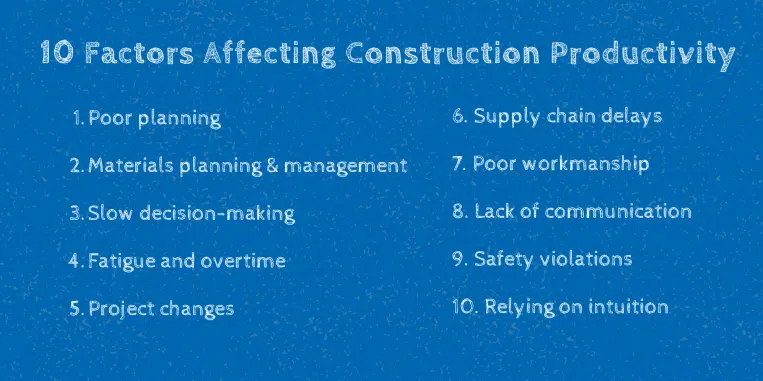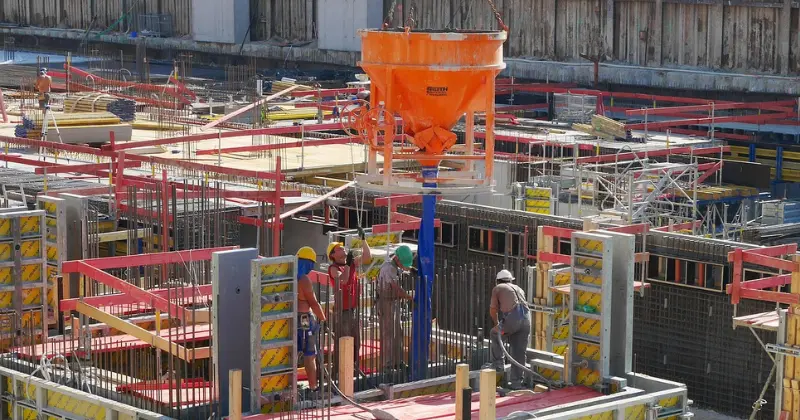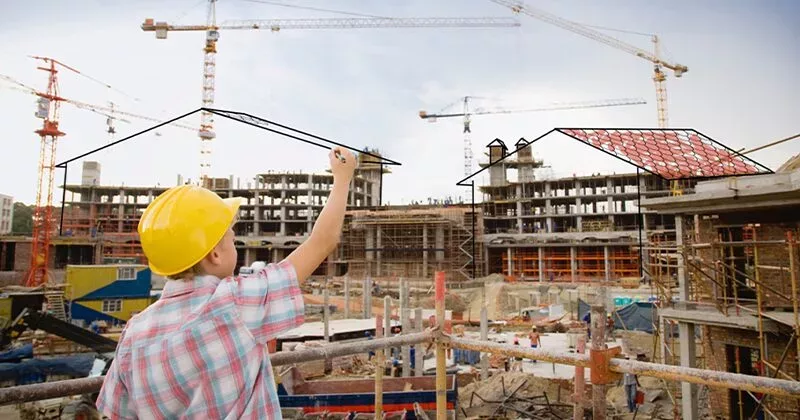11 mins read
What Impacts Construction Productivity & What To Do About It

One of the major problems in construction project management is that productivity is not improving as rapidly as the industry is developing. This issue holds back many projects, which all contractors and construction companies must address.
To tackle the issue effectively, it is necessary to understand what is slowing down productivity and what steps can be taken to improve it.
This RIB guide outlines everything you need to know to understand low productivity in the construction industry and some best practices for improving it in your projects.
Let’s dive in!
What Is Productivity In Construction?
Construction productivity is a term used to describe how efficient a company is at completing all the tasks involved in a project within the expected time. Productivity is usually measured using KPIs and software that provides performance insights to improve it.
Productivity is defined as the rate of output per unit of input. An output is something like a completed task or project, and inputs include the work, time, and materials consumed. In other words, these KPIs look at how much work is completed with a set amount of time, labor, materials, and other resources. No two projects are identical, making construction productivity harder to define and measure.
The best way to assess it is by examining costs, work hours, and resources used over time and comparing these numbers to work completed. Eventually, enough data can be collected to set baseline productivity values that indicate how efficiently the team performs.
When different managers, contractors, subcontractors, and clients measure productivity differently, this can lead to disagreements or confusion. For example, if a general contractor thinks it should take 40 hours to wire a 1000 square ft. building, and the electrical contractor believes it should take 60 hours, they might have differing views on the acceptability of the results. Different stakeholders might also measure productivity in other ways, such as measuring the feet of wire installed instead of the square footage of the space. This is why it is important to standardize how productivity in construction management is measured using common processes and digital tools.
The variety of conditions encountered also makes it harder to measure construction industry productivity compared to industries like manufacturing, which are more consistent and repetitive. Everything from the weather to leadership skills can come into play, so low productivity in construction jobs doesn’t always come down to the workers themselves. Let’s expand on that a little bit below.
Understanding Low Productivity In the Construction Industry
Construction productivity has developed a reputation for being the lowest of any industry. In a 2023 report by RICS, 45% of industry leaders said their productivity was unchanged over the past 12 months, and only 42% expected things to improve during the 12 months ahead. The first step towards solving this problem is recognizing and studying the issue so that solutions can be found.
The productivity of construction workers needs to be measured regularly and consistently to find out what changes have the most impact. Collecting more information also gives us important clues. For example, productivity improved for industrial buildings between 2019 and 2022 but dropped for highways, streets, and bridges during the same period. Differences in working conditions, like heat, ready access to food and water, and commute issues, should be reviewed further.
It hasn’t always been this way. In fact, before 1970, the US construction sector was more productive than the overall economy. However, workers in the sector today produce even less than in 1970, while overall productivity in the US has doubled in the same 50-year period. This same issue is being experienced worldwide, and productivity experts have developed theories on why low productivity rates in construction continue. Different measurement methods between projects and teams can explain some of the drops. Still, other issues being looked at include over-regulation, informality on job sites, high worker turnover, and, in rare cases, corruption.
The manufacturing industry has been a model since WWII, with productivity in sectors like automotive manufacturing climbing yearly. The variation of work in the industry makes it harder to implement some standard manufacturing efficiency practices, but many still apply. Design and supply chain practices can be improved by using modern technology to support programs like just-in-time material delivery and standard design libraries that make projects flow more smoothly from beginning to end. Prefabrication, such as prefab concrete, and robotics are other uses of technology that are slowly spreading from factories to job sites.
Construction industry productivity issues extend well beyond the United States and Canada.
- In Australia, 30 years of weak productivity are being blamed for $47 billion in lost opportunity, with only half of all project owners hitting their completion deadlines.
- The United Kingdom (UK) has experienced similar issues. Productivity has dropped even as construction jobs increased to 9% of all employment.
- In recent years, South Africa has experienced more serious material availability issues and a lack of experienced workers and supervisors, which negatively impact productivity.
- China’s construction industry has done well in meeting deadlines, but low productivity and labor shortages continue to impact it.
While the issues causing low productivity of construction workers differ in each region, all these countries are looking into new technology and digital techniques to help them turn the corner.
10 Factors Affecting Construction Productivity

- Poor Planning
Preconstruction planning is essential for a productive project ahead. One of the biggest problems in any construction endeavor is a lack of planning at the start, which could lead to various on-site challenges and delays.
For example, insufficient planning could result in a lack of necessary equipment available on-site when needed, which could cause a significant delay in productivity.
Poor planning can also lead to confusion in the workflow ahead. If all individuals involved in the project are on different pages, then each process takes much longer to manage.
2. Materials Planning and Management
Beyond planning the project’s workflow, proper materials planning is crucial, too. If material estimates are inaccurate, the right amount of building materials will not be available when needed. This will cause unnecessary delays in the construction schedule and negatively impact productivity.
Collaboration among team leaders and other stakeholders is one of the best ways to improve material planning practices. Improved construction communication provides better insight into actual material requirements. Planning activities should be aligned with the project schedule to ensure materials are ordered and delivered at the right time.
One big factor that could impact productivity is the contractor’s inability to make fast decisions due to a lack of access to the right information. Project managers and contractors need easy access to all relevant project data in real-time to ensure strategic decisions can be made when needed. A smart construction management solution like RIB BuildSmart gives every project stakeholder access to the latest data available to inform their decisions and boost productivity.
Unlike machines, human workers have limits, and their productivity begins to drop once they reach these limits. As you get to grips with how to improve productivity on a construction site, it is important to understand that the work often relies heavily on manual processes which is tiring for workers. If workers are tired and overworked, this can severely affect their productivity, cause more errors, or lead to safety issues.
When construction managers expect too much from their workers, productivity is affected. This is especially true in hot climates where workers tire more easily. Being able to balance work with time off and strategic breaks is essential.
Changes that occur during a project can significantly slow down productivity. These changes can be out of your control but can also happen due to a lack of planning or design errors.
A clear, shared set of information should always be available to avoid changes creating delays, as should a construction change management plan to ensure all stakeholders are involved and respond to changes immediately.
It is essential to choose material suppliers carefully and closely monitor their delivery and quality performance. Poor quality can lead to unexpected delays when materials must be replaced in the middle of a project. Modern inventory methods like just-in-time (JIT), where materials are ordered and delivered in smaller, more frequent batches to prevent waste and shortages, can reduce overstocking and minimize the impact of quality issues by keeping stock levels down.
Supply chain delays can also be prevented by planning for possible transportation issues or disruptions and having contingency plans in place to fall back on when needed. Delays and shortages greatly impact productivity when workers sit idle (or sit at home) waiting for materials to arrive.
Poor workmanship or a lack of skills is a common factor impacting construction productivity. If a task is done incorrectly, it will need to be redone, which is expensive and time-consuming.
Managers must ensure that all workers are properly trained and briefed on all tasks before work begins. The project should run smoothly if everything is done correctly from the start.
Communication and productivity are very closely linked. If communication is poor throughout a project, the situation can veer off course.
Communication needs to remain clear and concise between everyone involved in the project. This includes communication between managers and construction workers, architects, engineers, subcontractors, and clients.
Safety is closely related to productivity in construction because workers can focus on the task at hand more quickly when they don’t need to worry about safety hazards. At the same time, safety issues can lead directly to accidents that can temporarily halt all work.
Safety violations also have legal consequences that can divert attention away from productive work, impacting morale, worker turnover, and company reputation. Workers might also need to be redirected from more productive work to help correct a safety issue.
Generating regular construction reports to track the safety measures implemented in the project is a great way to ensure smooth and safe operation.
Construction is an age-old industry where thinking on your feet and relying on intuition and common sense are essential traits. Still, this can cause productivity issues when workers or supervisors improvise or make unplanned changes that are less efficient.
Over-reliance on intuition can also lead teams to believe they are being productive and taking the most efficient approach without comparing their output to any standard metrics. While intuition serves a purpose, it can sometimes cause leaders to veer off course when it is relied on as a guide to improve construction productivity.
How to Improve Construction Productivity
Learning how to improve productivity on a construction site is challenging, but it can be done by combining some best practices and modern ideas. Above all, productivity comes down to people, so keeping workers motivated, happy, and healthy should always be a high priority.
Use the Right Construction Productivity Software
Companies need to use the right technology to respond to these productivity issues. Adopting a digital construction approach is necessary for improving planning, project management, and communication. Management teams worldwide are beginning to include digital tools as they try to reverse the low productivity trends of the past few decades.
Software solutions, such as RIB BI+, align information across the company so all stakeholders can easily access the needed data. With a central system, you can make faster, smarter decisions with real-time analysis. This plays a vital role in enhancing efficiency throughout your company.
Do a Construction Productivity Analysis
Productivity analysis isn’t as difficult as it sounds, especially when you have the right tools to measure and track your metrics. To complete a productivity analysis, you need to know where you stand, which requires data, such as where hours are spent and how much work of each type is completed in those hours. Foremen and supervisors should set aside at least 15-30 minutes daily to collect and input data.
Once you have collected enough data, productivity software can perform its magic. The software will analyze the data to tell you where and when you are being productive and where you can improve.
Focus on Planning and Design Stages
As Benjamin Franklin once said, “If you fail to plan, you plan to fail.” There are always ways to become more efficient and less wasteful in all phases of a project, but productivity in construction begins in the earliest stages. The design, budget, and schedule must be detailed and accurate to prevent confusion, material delays, quality problems, and other time-draining issues caused by inadequate planning and design.
Poor designs can also lead to disruptive safety issues if the equipment, processes, and materials needed to build the design safely aren’t available and workers need to complete dangerous manual tasks.
Provide Employees with Adequate Training
Even when workers are scarce, or turnover is high, there is never a good reason to ignore employee training. Ongoing training helps workers feel more confident as they avoid mistakes and unsafe practices. Training also helps build the motivation all workers need to become more productive.
Training is valuable for productivity measurement and analysis. Well-trained teams perform tasks consistently, making setting realistic baselines and standards easier. Workers and supervisors should also be trained to report on productivity regularly to remove any guesswork from the analysis.
Construction software allows you to analyze your data to determine your productivity. It also tells you what is possible with more effort, less waste, or both. This information is the key to setting realistic goals.
Goals are important for building motivation or designing incentives like cash bonuses or days off based on performance. On the other hand, unrealistic deadlines and goals can deflate morale and have the opposite effect on efficiency. SMART (specific, measurable, attainable, relevant, time-based) goals point productivity in a positive direction.
Conclusion
Productivity should be a primary focus for any contractor. Understanding common factors that impact construction productivity is essential, as it helps companies improve project planning and management.
Contractors must consider all the above points and apply the right technology to enhance these processes. Focusing on each of these areas and supporting yourself with the right construction software solutions can vastly improve your operations.
If you are ready to skyrocket your productivity with the help of a professional construction toolkit, book a demo for RIB today!
Most Recent
11 mins read
10 mins read
10 mins read
29 mins read
Blog Categories

Ebook











